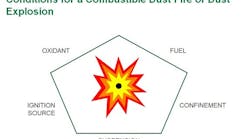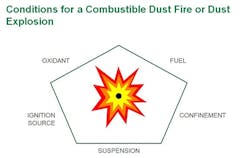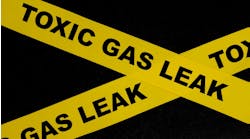Take Key Steps Against Combustible Dust Hazards
Effectively Managing fire and explosion hazards posed by combustible dust can be a challenging task. After all, this requires not only a detailed understanding of the fuel/combustible material (dust) but also an understanding of the process equipment, operating conditions, maintenance practices, engineering and administrative controls currently in place, process design strategies, hazards analysis methods and the site’s safety culture. It’s not unusual to find facility management with a good understanding of a process but a limited understanding of the hazards posed by the combustible dust in the process.
Most organic solids are capable of burning when all three elements of the familiar fire triangle — fuel, heat and oxygen — are present at the same time. Any appropriate source of energy can supply the heat, and high enough concentrations of fuel and oxygen must exist to support combustion.
On the other hand, if a sufficiently large concentration of combustible dust is suspended and ignited in an enclosed space, the resulting combustion would develop pressure that can cause injuries and fatalities as well as damage or destroy equipment and buildings. The elements of dust suspension and combustion confinement commonly are added to the fire triangle to depict the “dust explosion pentagon” (Figure 1). If any element of the pentagon is missing, an explosion won’t occur. However, in the absence of confinement, suspended dust still can combust, creating a “flash fire” or fireball that can create a hazard to people and potential property damage.
Figure 1. An effective mechanical integrity program can prevent conditions that can lead to an explosion.
This article outlines an effective approach to addressing combustible dust hazards by implementing a proactive and robust mechanical integrity (MI) program.
Program Essentials
Generally speaking, an MI program aims to manage the maintenance of all processing equipment and control systems of a facility to ensure the process is operating safely and within its intended parameters. If equipment or systems are run outside their safe operating limits, the potential for equipment failure clearly is much higher.
At minimum, MI includes the inspection, testing and preventive maintenance of “safety critical” equipment, i.e., those units whose failure or malfunction could result in a combustible dust fire or explosion. A more-comprehensive approach to MI would cover all process equipment that could contain combustible dust during normal or abnormal conditions, along with instrumentation and alarm/interlock systems used to prevent combustion. Equipment in the scope of the MI program must remain “fit for service” for its entire lifecycle, from procurement and receiving to installation, maintenance and decommissioning.
Three brief examples demonstrate the importance of MI to the control of combustible dust hazards:
1. Overheated bearings are a well-known ignition source for combustible dust. Depending on the specific service, equipment may require an anti-friction bearing design. The bearings must be maintained per manufacturer recommendations, with proper lubrication and cleaning at a frequency that would prevent a hazardous buildup of dust. Alternatively, the design should provide for bearings that are outside the dusty environment.
An effective MI program would include temperature monitoring of the bearings, either by manual or automated means, to verify the bearing temperature remains at a safe margin below the layer minimum ignition temperature (LMIT) of the powder. LMIT typically is determined by a laboratory test according to ASTM E2021. For an automated monitoring system, maintenance must ensure a high degree of reliability.
2. Poorly maintained equipment in combustible dust service may leak or spill powder to the floor and onto equipment surfaces in the work area. Besides the obvious hazard of providing fuel in the form of a combustible dust layer, an additional hazard exists if a dust layer accumulates on equipment that can develop temperatures that could cause ignition of the powder.
Containment of dust within equipment will depend on frequent inspections or audits to detect incipient failures that could lead to leakage or spills. Also, equipment that could be exposed to combustible dust accumulation must operate with a surface temperature well below the LMIT of the powder according to ASTM E2021. In addition, it may make sense to determine the minimum ignition temperature of the dust cloud according to ASTM E1491 for the powder of interest.
3. To protect personnel, the facility and the community from the effects of an explosion should an explosive rupture of equipment occur, some processes call for special measures to minimize the consequences. The options are explosion relief venting, explosion suppression or explosion containment in a vessel that can withstand the maximum dust explosion pressure. The design of any explosion protection measure (venting, suppression or containment) requires appropriate data concerning the severity of the dust cloud explosion (maximum explosion pressure and Kst). These data are obtained by performing a laboratory test on a representative dust sample in accordance with ASTM E1226. The MI program should include regular inspection of explosion vents, quarterly tests of explosion suppression systems, and periodic checks of vessel integrity according to recognized and generally accepted good engineering practices (RAGAGEP) such as API 510 and API 570, and FM Global Data Sheet 7-43 [1,2,3]. Inspections and non-destructive tests should be performed by personnel with appropriate training and experience, and at a frequency that would ensure fit-for-service performance during the interval between the inspections and tests.
MI program and housekeeping requirements appear in NFPA 652 [4] and in industry/material-specific standards such as NFPA 654 [5], NFPA 61 [6] and NFPA 484 [7].
Crucial Difference
Developing and implementing an effective MI program for managing combustible-dust fire and explosion hazards builds on an understanding of the maintenance activities required to minimize such hazards. These MI activities may differ from ordinary maintenance performed to keep the equipment operating as designed.
We are bringing together industry leaders in hazard identification, evaluation and control for combustible dust hazards for exclusive roundtable discussions. Our moderator, Guy Colonna, senior director of the National Fire Protection Association, will challenge our panelists with tough questions in order to increase awareness of the hazards and the available safeguards of fires and explosions within combustible solids processing and handling industries. You can register for Part I and Part II here.
A dust hazard analysis by competent personnel will identify locations where combustible dust fires and explosions could occur. These would include process equipment where dense clouds of dust and ignition sources could form, and process areas where loss of containment of combustible dust from equipment could happen (or is happening). By focusing on combustible-dust fire and explosion prevention, a site can much more easily identify and address equipment and locations needing additional maintenance.
To the extent practical, to prevent release of combustible dust, set up maintenance activities and a maintenance schedule to ensure the MI of process equipment. In some cases, changes in equipment design or in operating conditions may reduce the necessity for maintenance. In other cases, periodic maintenance won’t suffice to prevent accumulation of combustible dust inside and outside the process equipment. For these cases, implementing an effective housekeeping program is essential. This may require shutting down equipment periodically to check for and remove dust accumulations inside equipment and connecting ductwork.
Finally, subject any process changes, even if they appear to be insignificant, to a management-of-change process to determine if the change could increase (or decrease) the likelihood of ignitable dust clouds. A rise in likelihood may require an increase in maintenance effort and more frequent housekeeping.
Equipment Issues
Let’s now look at four areas — ductwork, flange and fitting connections, process interlocks and hybrid mixtures — that often require attention, and some fixes that effectively address issues identified.
Ductwork. Accumulation of combustible dust in exhaust ductwork or ductwork connecting equipment can pose a multifaceted combustible-dust fire and explosion hazard. First, the dust accumulation can be the source of a primary dust explosion under the right conditions; and second, the connecting ductwork can foster a secondary explosion by conducting the flame front and pressure wave from a primary explosion.
Always keep in mind that implementation of a sound MI program starts at the design phase. Knowing the bulk density of the powder that the ductwork will convey is important for designing the conveying system to prevent accumulation. This means maintaining a velocity sufficient to keep the dust from settling and minimizing the number of sharp bends in the ductwork. The ductwork requires periodic inspection for dust accumulation and thorough cleaning (using appropriate tools and methods) at intervals determined by the amount of accumulation. A check of the velocity with an appropriate anemometer provides a level of confidence that the ductwork is performing as designed. You many need to rebalance a combustible dust ventilation system to account for changes, e.g., addition of a branch exhaust duct.
Flange and fitting connections. I have seen numerous examples of operating equipment visibly leaking large quantities of combustible dust into the surrounding work area. In the worst case, I observed dense dust clouds. Such issues most commonly occur at plants that don’t have high standards of sanitation and housekeeping. In one case, a gasket designed to seal two 10-in.-dia. flanges in a combustible dust transfer line had failed and was replaced by copper mesh cut to size. Needless to say, this seal offered less-than-optimal integrity; the flange connection continually leaked powder onto the equipment and floor. The solution here was to continuously clean fugitive dust while the equipment was in operation until the plant procured and installed a gasket of appropriate material of construction.
At a different location, I noticed that the MI of a flange connection was compromised by the deliberate removal of approximately half the number of bolts that held the flanges together. This reportedly was done to ease disassembly of the equipment for maintenance. In this case, the nominal equipment inspections for sources of fugitive dust obviously weren’t effective. The short-term fix was to stop operation of the equipment until the plant could locate and install replacements for the missing bolts. The longer-term solution recommended to site management involved requiring accountability that flange disassembly had taken place per written procedures and recognizing the increased exposure of personnel to flash fire and explosion hazards resulting from failure to follow written procedures.
Process interlocks. I’ve frequently visited sites with combustible dust processes that ignore maintenance of safety-related interlocks or assume it’s unnecessary. Such interlocks include devices such as quick-closing valves in transfer piping and explosion-protection units on vessels where a combustible dust cloud could arise. This deficiency typically occurs at sites with relatively high turnover of personnel responsible for process safety and ones with relatively low awareness of combustible dust hazards.
At one pharmaceutical plant, a fluid-bed granulator was “protected” by quick-acting explosion isolation valves in the inlet and outlet piping and an explosion-suppressant device. Yet, I couldn’t find any inspection or maintenance records for this equipment. So, I recommended the site contact the vendors of the equipment to ensure that qualified personnel perform inspection and non-destructive testing of all protective devices per RAGAGEP.
Hybrid mixtures. The hazard of hybrid mixtures (i.e., a combustible dust suspended in a flammable liquid vapor) is well known [5]. Processes with the potential for a hybrid mixture require considerable analysis at the design stage to discover and address hybrid mixture explosion scenarios. Such mixtures often require layers of protection (preventive and protective measures) against an explosion that exceed the standard methods to reduce the fire and explosion risk of the flammable liquid vapor alone or the combustible dust alone.
I led a process hazard analysis team in a design-stage review of a batch reaction process to manufacture a skin care product. One step in the process involved introducing a raw material into a reaction vessel. The material was a) a combustible dust and b) wet with aqueous ethanol solvent. The team made numerous recommendations for engineering and procedural controls to minimize the risk of a fire or explosion. Key recommendations included:
• using static dissipative bags to hold and transfer raw material, with bags grounded before transfer of material;
• charging raw material to the vessel under vacuum through the bottom valve;
• limiting the batch quantities of flammable and combustible material in the vessel; and
• monitoring the temperature inside the vessel to ensure the mixture remains at least 10°C below the nominal flash point of the solution.
Risk-Based Inspections
A relatively recent development in ensuring MI involves risk-based inspections (RBI) and risk-based maintenance (RBM) actions that follow the inspections. The RBI approach utilizes a qualitative or quantitative determination of risk for a facility’s equipment or assets. The level of risk drives the allocation of resources (time and money) to perform RBM activities. The risk determination should be made by a suitably qualified team of process experts who have comprehensive knowledge of equipment operating conditions and failure modes.
A Key Element
A sound MI program is an essential component for effective control of combustible-dust fire and explosion hazards. Using appropriate process information, material (powder/dust) combustibility data, and industry standards, a site-specific MI management system can be designed and implemented to address these hazards efficiently and effectively with the resources available.
ROBERT GAITHER is a senior process safety specialist for DEKRA Process Safety, Princeton, N.J. Email him [email protected].
REFERENCES
1. API 510: “Pressure Vessel Inspection Code: In-Service Inspection, Rating, Repair and Alteration,” 10th ed., Amer. Petr. Inst., Washington, D.C. (2014).
2. API 570: “Piping Inspection Code: In-Service Inspection, Rating, Repair and Alteration,” 4th ed., Amer. Petr. Inst., Washington, D.C. (2016).
3. “Loss Prevention in Chemical Plants,” property loss prevention data sheet 7-43, paragraphs 3.1.1.3, 3.1.2.6, 3.1.2.6.4 and 3.1.3.1.6, FM Global, Johnston, R.I. (2015).
4. NFPA 652: “Standard on the Fundamentals of Combustible Dust,” paragraphs 7.3.4.2.1, 7.3.4.2.2, 8.4, 9.4 and A.8.4.2.1.1 to A.8.4.7.1, Nat. Fire Protection Assn., Quincy, Mass. (2019).
5. NFPA 654: “Standard for the Prevention of Fire and Dust Explosions from the Manufacturing, Processing, and Handling of Combustible Particulate Solids,” paragraphs 5.2.4, chapter 8, paragraphs 12.1.2, A.6.5.2 to A.8.2.1.3, A.8.2.2.5, and Annex D, Nat. Fire Protection Assn., Quincy, Mass. (2017).
6. NFPA 61: “Standard for the Prevention of Fires and Dust Explosions in Agricultural and Food Processing Facilities,” paragraphs 8.4 and A.8.4.2.2, and Figure F.3, Nat. Fire Protection Assn., Quincy, Mass. (2017).
7. NFPA 484: “Standard for Combustible Dusts,” paragraphs 8.2.1, chapter 9, and paragraphs A.9.3 to A.9.9.3, Nat. Fire Protection Assn., Quincy, Mass. (2019).
8. Combustible Dust (poster), U.S. Occupational Safety & Health Admin., Washington, D.C., available at www.osha.gov/Publications/combustibledustposter.pdf.
9. “Asset Integrity,” property loss data sheet 9-0, paragraphs 3.3.1.2.3 D, FM Global, Johnston, R.I. (July 2018)




